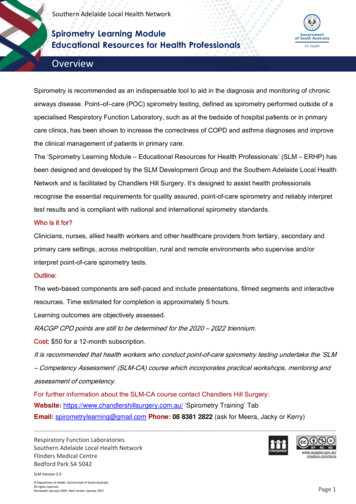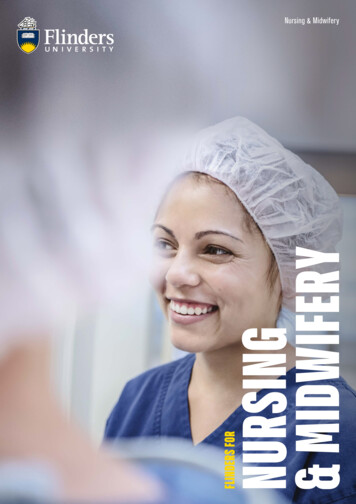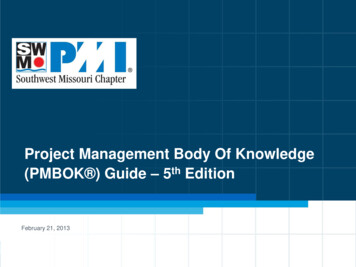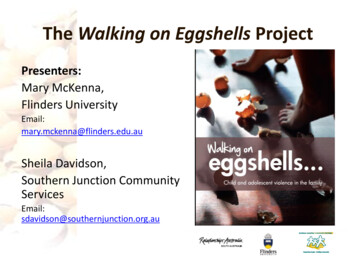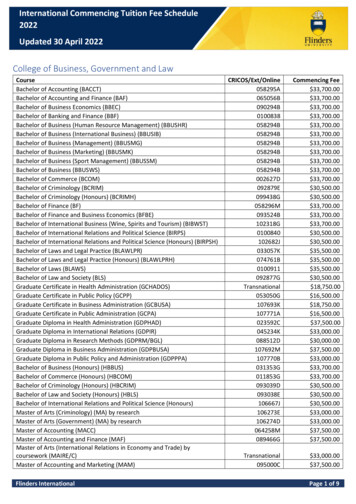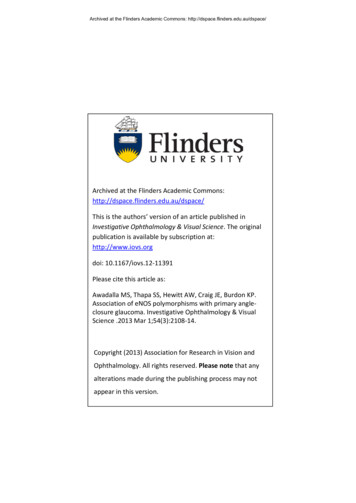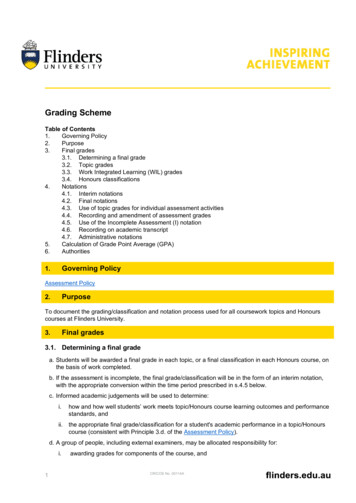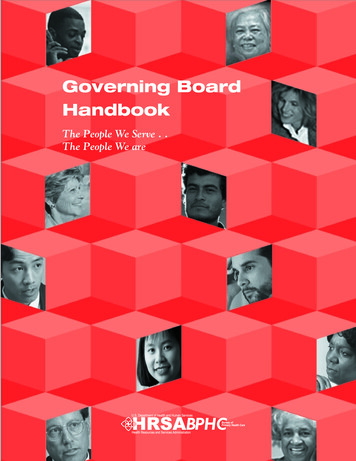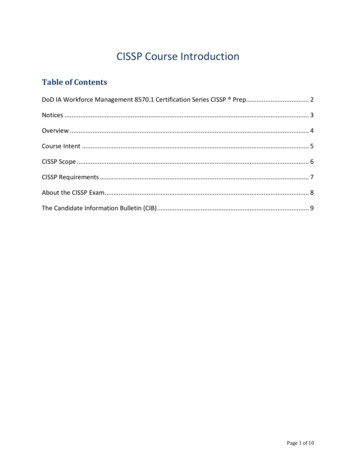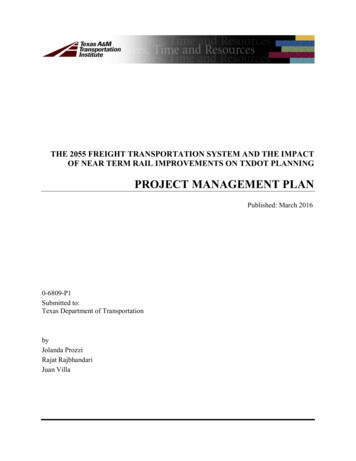
Transcription
Driver and Vehicle Safety ProceduresTable of ContentsGoverning Policy1.2.Purpose3.Scope4.Definitions5.University vehicle safety requirements6.Non-University vehicles7.Use of University vehicles for private or other purposes8.Authorised drivers9.Drivers’ licence requirements10. Driver responsibilities11. Risk management12. Driver fatigue13. Reporting accidents/incidents14. Training15. Record keeping16. Responsibilities17. Related documentsGoverning Policy1.Work Health and Safety PolicyWork Health and Safety Management SystemPurpose2.a. These procedures establish responsibilities and actions required to manage the risks to health and safetyassociated with the use of motor vehicles, in accordance with legislative requirements and theUniversity’s Work Health and Safety Policy.b. These procedures should be read in conjunction with the University’s motor vehicle Fleet bookings.Scope3.a. These procedures apply to:i.all workers, students and visitors who drive a University vehicle, a rental vehicle or their own vehiclewhilst conducting University workii. staff members who are permitted to garage a University vehicle at home, but do not have authority forfull private use of that vehicle.b. These procedures do not apply to vehicles that are part of a salary package arrangement or novatedlease agreement. All other vehicles are covered by these procedures.1CRICOS No. 00114A
Definitions4.Portfolio HeadsVice-Chancellor, Deputy Vice-Chancellor (Students), DeputyVice-Chancellor (Research), Vice-President and Pro Vice-Chancellor (International),Vice-President (Corporate Services).WorkersUniversity staff, contractors and sub-contractors and their employees, labour hirecompany employees, trainees, students gaining work experience and volunteers.StudentA person enrolled in a topic or course of study at the University.University vehicleUniversity fleet vehicles, pool vehicles, College/Portfolio vehicles, including nonstandard vehicles such as quad bikes, motor bikes, trailers, electric vehicles.Excludes: forklifts, elevated work platforms (EWP), cranes, scissor lifts, which havespecific training and licensing requirements under WHS Regulations boats and vessels for the purpose of these procedures, vehicles that are part of a salary packagearrangement or novated lease agreement.Remote and/orisolatedtravel/workSituations where a person or persons may be exposed to risks because the area orenvironment they are travelling or working in is remote from others or isolated fromaccess, communication and the assistance of others.Long distanceDistance travelled covering an approximate range of 200km or driving longer than 2hours.University vehicle safety requirements5.a. All University vehicles, including those that are leased or hired, should, where possible, have a 5-starANCAP safety rating. If a vehicle is required for a specific purpose and a suitable vehicle cannot besourced to meet this standard, an alternative vehicle may be sourced.b. As a minimum, the following safety features should be standard on University vehicles:i.driver airbagsii. stability controliii. Anti-lock Brake System (ABS)iv. cargo barrier for SUVs/wagonsv. first aid kit are available in most vehicles or can be borrowed from Property, Facilities andDevelopment on request when driving outside metropolitan areas.Note: these are basic kits and are not intended to cover higher risk activities such as field trips. Thelocal area is responsible for providing field trip first aid kits.vi. quad bikes must have roll over bars or relevant stabilizing protection. For other non-standardvehicles, other safety requirements may also apply, and these should be identified before usethrough a risk assessment.vii. electric vehicles may require charging, this needs to be considered and managed particularly iftravelling long distances.2CRICOS No. 00114A
c. The relevant College/Portfolio or Property, Facilities and Development must ensure University vehiclesare serviced in accordance with the manufacturer’s specifications by a dealership or manufacturer’sagent at intervals specified by the manufacturer.d. Vehicles must be maintained in a safe and roadworthy condition and any damage or faults must berepaired promptly.Non-University vehicles6.a. Rental vehicles may be used for University business provided such vehicles and activities comply withthese procedures.b. The use of University vehicles or rentals is the preferred option for University business. However, wherethis is not possible or practicable, privately owned vehicles may be used for University business providedthat as a minimum the vehicle is:i.registeredii. roadworthyiii. covered by insurance.c. If private vehicles are used, the University is not liable for any damage to the private vehicle, or any otherdamage caused by that vehicle.d. Private vehicles used must be fit for purpose.e. Drivers are responsible for payment of any parking and traffic infringements incurred.f. Drivers must be aware of their responsibility for any accident or other emergency when driving theirvehicle.7.Use of University vehicles for private or other purposesa. University vehicles must be used for University business purposes only and are not to be used for privatepurposes except as stated in Procedure 7.c and 7.d below.b. Driving to and from home directly before or after a business journey is acceptable, provided the vehicle isnot used for any private purposes while in the driver’s possession overnight.c. Any exceptions will require staff/students to seek approval in writing from their relevant local areamanager and then submit the request for approval to the relevant Director of College Services / PortfolioHead or nominee.d. University vehicles should not be used by students for Work Integrated Learning, except where there is acontractual agreement linked to a funding program, in which case the relevant Vice-President andExecutive Dean of College or nominee must give approval in writing.8.Authorised driversa. University vehicles are available for use by staff who have been approved by their supervisor/manager.b. The relevant supervisor/manager must approve any student or visitor (here on University business) touse University vehicles. Students and visitors must meet all the requirements for motor vehicle use asspecified in these procedures.c. University vehicles must not be driven by anyone other than authorised drivers, except that in anemergency a person with a valid and current driver’s licence may drive the vehicle.d. Volunteers are only permitted to drive University vehicles on an approved University activity asnominated on the volunteer engagement form.e. All drivers of vehicles for University business must complete the online driver induction quiz found on theweb page Fleet bookings.3CRICOS No. 00114A
Drivers’ licence requirements9.a. All drivers of University vehicles must hold a current and appropriate (to the vehicle class) driver’s licencefor driving in South Australia or other Australian State/Territory. A copy must be provided on request.b. Workers, students or visitors who hold a current driver’s licence from a non-Australian jurisdiction mustensure they carry the relevant licence and documentation as required by the respective state/territory.c. If international students or visitors are to reside in South Australia for more than 90 days, they mustobtain a South Australian licence (or respective State/Territory). See www.sa.gov.au for details.d. Drivers on a probationary licence must display ’P’ plates when driving a University vehicle, as required bythe road rules.e. Learner licence holders are not permitted to drive a University vehicle.f. Drivers must not drive while their licence is disqualified or suspended. If they do, they void all insuranceand are liable for all legal and other costs that are incurred.10.Driver responsibilitiesa. Drivers must drive safely and comply with the relevant road laws and the University’s Work Health andSafety policies, procedures and guidelines.b. Drivers found in breach of the road rules are responsible for all penalties imposed by the SouthAustralian Road Traffic Act 1961 (or interstate equivalent) and any recovery of costs, should the insurervoid the insurance cover.c. Drivers on University business must:i.be below the legal limit for alcohol when drivingii. not be under the influence of any drugs, whether illicit, prescribed or non-prescription, whilstdriving the vehicleiii. if taking medication, ensure that it does not affect their ability to drive safely.d. Drivers must advise the University if they become aware of any defects that may affect the safety orroadworthiness of the vehicle.e. Drivers must wear a seat belt at all times and ensure that their passengers also wear seatbelts.f. Smoking is prohibited in all University vehicles.g. Hand-held mobile phones must not be used whilst driving.h. University 2WD vehicles must not be driven on designated 4WD tracks or off-road where driving a 2WDvehicle would pose a risk or cause damage to the vehicle.i. When towing trailers, boats, caravans or other towable equipment, drivers should review the TrailerGuidelines and must ensure that:i.the vehicle to be towed is in good conditionii. the towing vehicle is suitable for the vehicle/equipment being towediii. the load is restrained as requirediv. the towing vehicle is comprehensively insuredv. the manufacturer’s towing limits are adhered to.j. Drivers must not transport passengers not engaged in University business (e.g. family and friends) inUniversity vehicles. If such a situation arises due to unusual circumstances, staff will need to seekendorsement in writing from their relevant local area manager and submit this for approval to the relevantDirector of College Services / Portfolio Head or nominee.k. Drivers must not transport hitchhikers.4CRICOS No. 00114A
l. Any accidents or damage to the vehicle regardless of whether any injury was sustained must be notifiedto the University as soon as reasonably practical or within 24 hours (see Procedure 13).m. Drivers are personally responsible for any traffic or parking fines imposed on a University vehicle whilstthe vehicle is in their possession.n. Except for assistance/support dogs, pets or other animals are not permitted in University vehicles unlessrequired for research or business needs.Risk management11.a. Health and safety risks associated with vehicles and driving must be managed in accordance with theWHS Risk Management Procedures.b. Vehicles must be fit for the intended use (e.g. for off-road, or ability to handle correct towing capacity).c. A risk assessment must be conducted for driving in situations where there is an increased risk, such asdriving to isolated and/or remote locations, long-distance driving, 4WD/off-road and driving in adverseconditions (e.g. extreme terrain, temperatures, flooded areas) The person undertaking this travel must, inconsultation with those who are to be involved with the travel, and before the driving starts:i.identify relevant hazardsii. identify control measures to manage the risks associated with driving as far as is reasonablypracticable, andiii. document the risk assessment in either the field trip process or other relevant risk assessment orother process.d. The manager or supervisor must:i.consider whether the driver has the appropriate driving experience for the intended journey.ii. authorise the completed risk assessmentiii. confirm that they are satisfied that so far as is reasonably practicable, all reasonably foreseeablehazards associated with the proposed driving have been identified and risks will be eliminated orminimised through the planned control measures.e. Risk assessment records must be retained by the local area.f. Non-standard vehicles should be risk assessed in line with any legislative requirements and for theparticular task they are undertaking.g. For long distance, remote, 4WD/off-road driving or driving in adverse conditions, the driver must ensurethat:i.first aid provisions are suppliedii. communication devices appropriate to the terrain and locality to be travelled are supplied.h. It is not recommended that hazardous chemicals or dangerous goods be transported via University orprivate vehicles. There are strict regulatory requirements around transport of these items and in the eventof an accident it is likely insurance will be an issue. Transport should occur via an appropriate couriercompany.i. Prior to travel in bushfire prone areas, see Bushfire safety.12.Driver fatiguea. All drivers must be aware of the signs and effects of fatigue when driving during the course of their workor study.b. Where possible, factors that contribute to fatigue (e.g. extended work hours, lack of adequate breaks)should be eliminated. Where this is not possible then risk control measures should be put in place. Forexample:5CRICOS No. 00114A
i. Work, including driving should be planned. Pre and post journey activities and the driving itselfshould be considered when assessing the risk of fatigue. A Journey Management Plan is available.ii. Where the working day involves working and driving, the working day should not exceed 12 hours inany 24-hour period.iii. If a driver identifies that they are feeling tired, regardless of how long they have been driving, theyshould stop and take a rest break.iv. Regular breaks should be taken approximately every two hours regardless of feeling fatigued or not.This may include a change of driver.c. Driving during normal sleeping times contributes to fatigue. Where possible workers should considerstaying overnight if the driving time exceeds normal working hours.13.Reporting accidents/incidentsa. Vehicle accidents that occur when conducting University business/activities and where someone isseriously injured or killed must be reported immediately to the relevant Police and the University’sAssociate Director, WHS.b. All other vehicle accidents/incidents that occur while conducting University business must be reported toProperty, Facilities and Development and/or the driver’s manager/supervisor as soon as reasonablypracticable and reported on the University’s online FlinSafe system within 24 hours.c. Vehicle accidents involving another vehicle, person or property must be reported to police as required bylaw in the relevant jurisdiction. In SA, in certain circumstances (e.g. if the damage is under 3,000 andno one is injured), the accident can be reported via the SAPOL Online Collision Reporting system.SAPOL should be contacted to clarify the requirements in each case.14.Traininga. Any training requirements (e.g. 4WD, quad bike etc.) must be identified as part of the risk assessmentprocess and provided before drivers use the vehicles for University business/activities.b. Drivers should discuss training needs with their supervisors.15.Record keepinga. Vehicle maintenance and inspection records must be retained by the relevant College/Portfolio orProperty, Facilities and Development.b. Any additional documentation, such as vehicle inspection checklist, risk management documents andtraining records must be kept by the local area.16.ResponsibilitiesCollege VicePresidents andExecutive Deansand Portfolio Headsa. Ensure that:i.these procedures are implemented in their College/Portfolioii. all processes outlined in this procedure are applied to those vehicles thatare managed by the College/Portfolioiii. there are adequate resources to manage all aspects of vehicles and driversafety, including training.Property, Facilitiesand Developmentb. Ensure that these procedures are implemented for fleet vehicles.Managers andsupervisors(includingc. Implement these procedures in their area of responsibility, including ensuringthat:6CRICOS No. 00114A
supervisors ofstudents)i.workers, students, visitors and others in the workplace are aware of theirresponsibilities in relation to driving and are provided with adequateinformation, training, instruction and supervisionii. field trip documentation is completed where vehicles are to be used as partof the field tripiii. driving to be undertaken as part of a field trip is assessed as part of the fieldtrip risk management processes.d. Approve vehicle use and authorise drivers as required.Workers, studentsand visitorse. Take reasonable care for their own safety.f. Comply with any lawful and reasonable directions regarding driving.g. Ensure that they comply with all aspects of these procedures.17.Related documentsWHS Risk Management ProceduresCode of Practice - How to manage work health and safety risksFlinders Field Trip GuidelinesTrailer guidelinesJourney Management PlanField trip risk assessmentApproval AuthorityVice-President (Corporate Services)Responsible OfficerDirector, People and CultureApproval Date18 May 2021Effective Date18 May 2021Review Date*May 2024Last amendedCM file numberCF17/212* Unless otherwise indicated, this procedure will still apply beyond the review date.Printed versions of this document are not controlled. Please refer to the Flinders Policy Library for the latest version.7CRICOS No. 00114A
emergency a person with a valid and current driver's licencemay drive the vehicle. d. Volunteers are only permitted to drive University vehicles on an approved University activity as nominated on the volunteer engagement form. e. All drivers of vehicles for University business must complete the online driver induction quiz found on the
